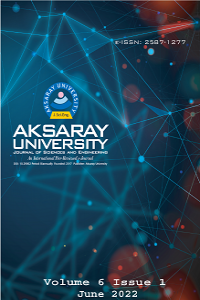Quantum Mechanics Approach for Appropriately Chosen Hamiltonian
Abstract
Risk theory has always played a significant role in mathematical finance and actuarial sciences. A novel approach to the risk theory of non-life insurance is quantum mechanics. To compute finite-time non-ruin probability, I introduce the quantum mechanics formalism in discrete space and continuous space with the appropriately chosen Hamiltonian. By using the quantum mechanics approach and the stochastic method, the non-ruin operator is defined, and tensor products of operator concepts are presented for several examples.
In this paper, Dirac notations are operated to find the Hamiltonian matrix with the eigenvector basis for two and three-state cases, and its tensor product version with a change of basis.
Keywords
Ruin Probability Risk Theory Hamiltonian Quantum Mechanics Dirac Notations Tensor Product Non-life Insurance
References
- [1] S. Asmussen and H. Albrecher, Ruin Probabilities (Advanced Statistical Science and Applied Probability), Second Edition (World Scientific, Singapore, 2010) pp. 19-30.
- [2] H. U. Gerber, An Introduction to Mathematical Risk Theory, First Edition (Huebner Foundation Monograph, R. D. Irwin Inc. Homeward Illinois, 1979) pp. 16-34, 110-113.
- [3] C. Lefèvre, S. Loisel, M. Tamturk, S. Utev, A Quantum-Type Approach to Non-Life Insurance Risk Modelling, Risks, 6(3) (2018) 99.
- [4] P. A. M. Dirac, Hamiltonian Methods and Quantum Mechanics, Proceedings of the Royal Irish Academy, Section A: Mathematical and Physical Sciences, 63 (1963) 49-59.
- [5] B. E. Baaquie, Quantum Mechanics and Option Pricing. In: Proceedings of the Second Quantum Interaction Symposium (QI-2008), (2008) 54-59.
- [6] B. E. Baaquie, The Theoretical Foundations of Quantum Mechanics, First Edition (Springer New York, New York, 2013).
- [7] D. J. Griffiths, Introduction to Quantum Mechanics, Second Edition (Pearson Prentice Hall, New Jersey, 2004) pp. 1-170.
- [8] J. Dimock, Quantum Mechanics and Quantum Field Theory: a Mathematical Primer, First Edition (Cambridge University Press, New York, 2011).
- [9] R. P. Feynman, Space-time Approach to Non-relativistic Quantum Mechanics, Reviews of Modern Physics 20(2) (1948) 367.
- [10] S. M. Ross, Introduction to Probability Models, Tenth Edition (Elsevier Academic Press, Oxford, 2010).
- [11] S. M. Ross, Applied Probability Models with Optimization Application, First Edition (Holden-Day, San Francisco, 1970) pp. 10-25, 61-65.
- [12] T. Mikosch, Non-Life Insurance Mathematics, Second Edition (Springer, Heidelberg, 2009) pp. 7-18, 155-159.
- [13] C. Lefèvre, and S. Loisel, On Finite-time Ruin Probabilities for Classical Risk Models, Scandinavian Actuarial Journal 2008(1) (2008) 41-60.
- [14] J. R. Norris, Markov Chains, First Edition (Cambridge University Press, Cambridge, 1997), pp. Preface-10, 73-81.
- [15] S. Jain, Markov Chain Model and Its Application, Computers and Biomedical Research, 19(4) (1986) 374-378.
- [16] Y. Suhov, and M. Kelbert, Probability and Statistics by Example: Volume 2, Markov Chains: a Primer in Random Processes and Their Applications, (Cambridge University Press, New York, 2008) pp. 1-17, 185-230.
- [17] J. J. Sakurai, Modern Quantum Mechanics, (Addison-Wesley Publishing Company, 1994).
- [18] K. L. Chang, Mathematical Structures of Quantum Mechanics, (World Scientific, Singapore, 2012).
- [19] M. S. Bespalov, On the Properties of a New Tensor Product of Matrices, Computational Mathematics and Mathematical Physics, 54(4) (2014) 561-574.
- [20] A. Kaya, Modern Mathematical Methods for Actuarial Sciences, (University of Leicester PhD Thesis. https://hdl.handle.net/2381/39613, 2007).
Abstract
References
- [1] S. Asmussen and H. Albrecher, Ruin Probabilities (Advanced Statistical Science and Applied Probability), Second Edition (World Scientific, Singapore, 2010) pp. 19-30.
- [2] H. U. Gerber, An Introduction to Mathematical Risk Theory, First Edition (Huebner Foundation Monograph, R. D. Irwin Inc. Homeward Illinois, 1979) pp. 16-34, 110-113.
- [3] C. Lefèvre, S. Loisel, M. Tamturk, S. Utev, A Quantum-Type Approach to Non-Life Insurance Risk Modelling, Risks, 6(3) (2018) 99.
- [4] P. A. M. Dirac, Hamiltonian Methods and Quantum Mechanics, Proceedings of the Royal Irish Academy, Section A: Mathematical and Physical Sciences, 63 (1963) 49-59.
- [5] B. E. Baaquie, Quantum Mechanics and Option Pricing. In: Proceedings of the Second Quantum Interaction Symposium (QI-2008), (2008) 54-59.
- [6] B. E. Baaquie, The Theoretical Foundations of Quantum Mechanics, First Edition (Springer New York, New York, 2013).
- [7] D. J. Griffiths, Introduction to Quantum Mechanics, Second Edition (Pearson Prentice Hall, New Jersey, 2004) pp. 1-170.
- [8] J. Dimock, Quantum Mechanics and Quantum Field Theory: a Mathematical Primer, First Edition (Cambridge University Press, New York, 2011).
- [9] R. P. Feynman, Space-time Approach to Non-relativistic Quantum Mechanics, Reviews of Modern Physics 20(2) (1948) 367.
- [10] S. M. Ross, Introduction to Probability Models, Tenth Edition (Elsevier Academic Press, Oxford, 2010).
- [11] S. M. Ross, Applied Probability Models with Optimization Application, First Edition (Holden-Day, San Francisco, 1970) pp. 10-25, 61-65.
- [12] T. Mikosch, Non-Life Insurance Mathematics, Second Edition (Springer, Heidelberg, 2009) pp. 7-18, 155-159.
- [13] C. Lefèvre, and S. Loisel, On Finite-time Ruin Probabilities for Classical Risk Models, Scandinavian Actuarial Journal 2008(1) (2008) 41-60.
- [14] J. R. Norris, Markov Chains, First Edition (Cambridge University Press, Cambridge, 1997), pp. Preface-10, 73-81.
- [15] S. Jain, Markov Chain Model and Its Application, Computers and Biomedical Research, 19(4) (1986) 374-378.
- [16] Y. Suhov, and M. Kelbert, Probability and Statistics by Example: Volume 2, Markov Chains: a Primer in Random Processes and Their Applications, (Cambridge University Press, New York, 2008) pp. 1-17, 185-230.
- [17] J. J. Sakurai, Modern Quantum Mechanics, (Addison-Wesley Publishing Company, 1994).
- [18] K. L. Chang, Mathematical Structures of Quantum Mechanics, (World Scientific, Singapore, 2012).
- [19] M. S. Bespalov, On the Properties of a New Tensor Product of Matrices, Computational Mathematics and Mathematical Physics, 54(4) (2014) 561-574.
- [20] A. Kaya, Modern Mathematical Methods for Actuarial Sciences, (University of Leicester PhD Thesis. https://hdl.handle.net/2381/39613, 2007).
Details
| Primary Language | English |
|---|---|
| Journal Section | Research Article |
| Authors | |
| Publication Date | June 30, 2022 |
| Submission Date | September 22, 2021 |
| Acceptance Date | January 26, 2022 |
| Published in Issue | Year 2022 Volume: 6 Issue: 1 |
Aksaray J. Sci. Eng. | e-ISSN: 2587-1277 | Period: Biannually | Founded: 2017 | Publisher: Aksaray University | https://asujse.aksaray.edu.tr
ASUJSE is indexing&Archiving in










